The Great White Shark (Carcharodon carcharias) is a true titan of the seas, embodying the raw power and majesty of the marine world.
With a lineage dating back millions of years, this apex predator has fascinated and inspired humanity, often drawing us into the depths of fear and admiration.
In this article, we embark on a thrilling journey to uncover some of the most fascinating facts about great white sharks. From the intricacies of their biology to their role in indigenous folklore, from awe-inspiring behaviors to tales of rare encounters with humans, we delve deep into the life of this iconic marine creature.
Are you ready to plunge into the depths and swim alongside the ocean’s most formidable predator? Let’s get right to it, then!
EXCLAIMER: As we explore the wonders and mysteries of the Great White, we should also try to shed more light on the importance of preserving and respecting these magnificent animals, the guardians of our oceans’ delicate balance. With every fact, we aim to foster a deeper understanding and appreciation for these incredible sharks, inspiring a commitment to their conservation and a renewed sense of awe for the wonders of the underwater world.
25 Interesting General Facts About Great White Sharks
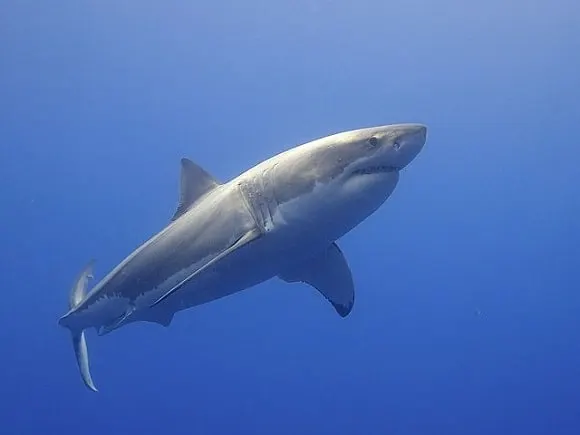
Scientific Classification
The Great White Shark, scientifically known as Carcharodon carcharias, belongs to the mackerel shark family, Lamnidae. This family also includes the mako, salmon, and porbeagle shark.
Global Distribution
Great Whites are widespread and found in cool, coastal waters worldwide, including the Atlantic, Pacific, and Indian Oceans.
Longevity
These sharks have an estimated lifespan of 70 years or more, making them one of the longest-lived cartilaginous fish on planet Earth!
Dietary Habits
Great Whites are apex predators, primarily feeding on fish, seals, sea lions, and carrion. Their diverse diet helps maintain balance in marine ecosystems.
Tooth Replacement
They possess multiple rows of serrated teeth, which can replace lost teeth throughout their lifetime, ensuring a constant, sharp bite.
Electroreception
Great Whites use the ampullae of Lorenzini, specialized electroreceptive cells, to detect the electromagnetic fields emitted by prey.
These cells are located in a series of pores on the shark’s snout and allow it to feel the intensity and direction of electrical currents underwater.
A highly-developed apex predator!
Buoyancy Control
Their large liver, rich in oil, aids in buoyancy control, allowing them to navigate different water depths efficiently.
Temperature Regulation
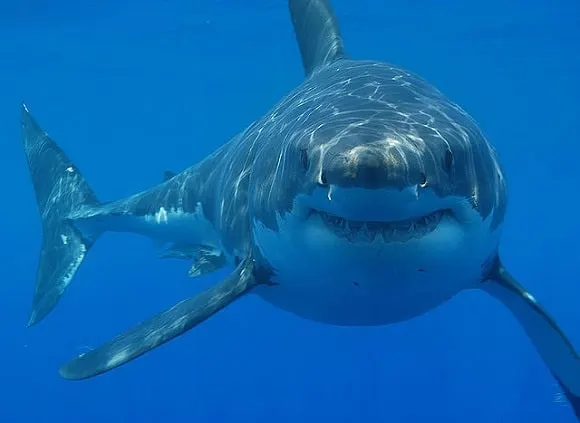
great white sharks are endothermic and capable of regulating body temperature, which enables them to inhabit a wide range of thermal environments that they can quickly adapt to and change between.
However, this fact also makes them consume energy at a very fast rate, forcing them to swim calmly and behave in a sit-and-wait style in between hunting occasions to be able to regain their energy after a fast pursuit.
Migration Patterns
Satellite tagging has revealed long-distance migrations, with some individuals traveling between California and Hawaii.
That’s a journey of roughly 2,500 miles! This showcases the Great White’s remarkable navigational skills and extreme durability.
Breeding Biology
Great Whites exhibit viviparity, giving birth to live young. Females have biennial or triennial reproductive cycles, with gestation generally lasting around 11-12 months.
Unlike most other fish species, female Great Whites grow their eggs and embryos internally until the young are ready for birth.
Additionally, mating occurs internally, which also is a highly unusual thing in the world of fish.
Pup Development
Great white shark pups are born well-developed, measuring around 5 feet (1.5 meters) in length, and are immediately independent, fending for themselves in the vast ocean.
Size and Growth
Adult Great Whites can reach lengths of over 20 feet (6 meters) and weights of 5,000 pounds (2200 kilograms) or more, with females typically being larger than males.
The biggest great white shark ever recorded is the famous female Deep Blue, an ocean giant that measures 20 feet (6.1 meters) and around 4,400 pounds (2000 kilograms).
RELATED ARTICLE: Read up on Deep Blue and learn more about the incredible size of great white sharks!
Speed and Agility
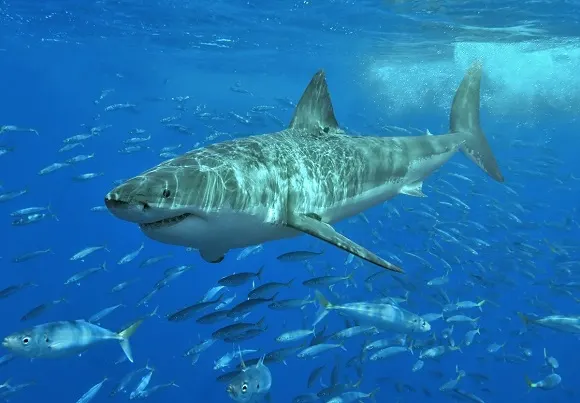
They can reach speeds up to 25 mph (40 km/h) and can leap out of the water, a behavior known as breaching, to catch prey.
Their maximum burst speed is estimated at 35 mph, which is pretty fast!
Social Structure
While often solitary, Great Whites often exhibit complex social structures, with larger individuals dominating smaller ones, particularly around feeding sites.
Sensory Adaptations
Their highly developed sense of smell enables them to detect blood at concentrations as low as one part per million, aiding in locating prey.
Conservation Status
The IUCN Red List classifies great white sharks as vulnerable on a global level and as critically endangered in Europe, with populations declining due to overfishing, bycatch, and habitat degradation.
Unfortunately, poaching and other illegal fishing practices play an important role in this decline.
Genetic Diversity
Genetic studies indicate distinct populations with limited gene flow, emphasizing the importance of regional conservation efforts.
Human Interaction
Despite their fearsome reputation, great white shark attacks on humans are rare, with most incidents resulting from mistaken identity or curiosity.
Over the last two centuries or so, there have been a total of 59 fatal great white shark attacks and a total of 351 unprovoked bites by Great Whites.
Statistically, that’s roughly 0.3 fatal shark attacks and 1.8 unprovoked bites by great white sharks per year.
So, there is an extremely small risk of dying, or even getting bitten, by a Great White. Please keep that in mind always!
Research and Tagging
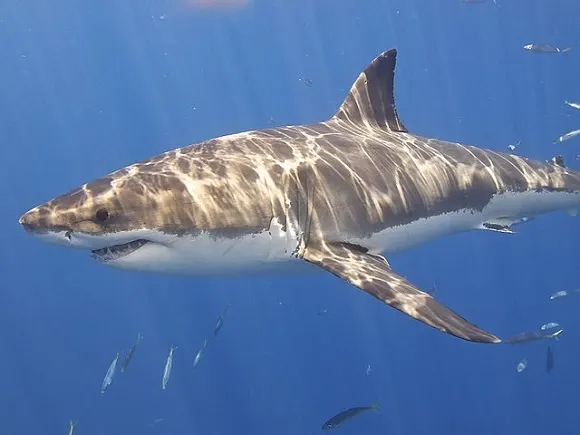
Ongoing research and tagging programs aim to understand their behavior, ecology, and movement patterns to aid in conservation and management.
More research and understanding of this magnificent creature is needed and vital to better manage and protect it in the future, and thankfully, the number of Great White research projects increases with every year that passes.
Cultural Significance
Great Whites hold cultural significance in various societies, often depicted in art, literature, and film, symbolizing the power and mystery of the ocean.
Economic Impact
Shark tourism, particularly cage diving, contributes significantly to local economies, promoting conservation awareness and appreciation for these majestic creatures.
Adaptation and Evolution
Fossil evidence suggests that Great Whites have been around for approximately 16 million years, evolving adaptations for survival in diverse marine environments.
That’s one big old shark right there!
Role in Ecosystem
As apex predators, they play a crucial role in maintaining the health and balance of marine ecosystems by controlling the populations of other species.
I repeat myself when I say that the continued survival of this species is extremely crucial for the future well-being of our oceans!
Threats and Challenges
Sadly, Great Whites face numerous threats, including climate change, habitat loss, pollution, and human activities, necessitating concerted conservation efforts.
Conservation Initiatives
Thanks to an ever-growing awareness, more research, and better funding, various organizations and governments are implementing conservation initiatives, including protected areas and fishing regulations, to safeguard the future of the Great White.
One prominent example is the Red Triangle area off the coast of California.
This famous marine mammal protection area now harbors close to 300 great white sharks, which is roughly 35% more than just 10 years ago.
Projects like these show how effective such measures can be!
Now, let’s move on to some little-known facts about the king of the ocean!
10 Awe-Inspiring Facts About Great White Sharks
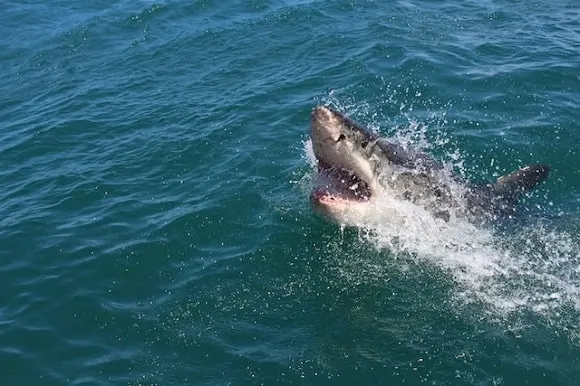
Lunar Influence
Great Whites are known to exhibit hunting behavior that is influenced by the lunar phase. Studies have shown increased hunting activity during a full moon, utilizing the additional light for hunting seals.
Dermal Denticles
The skin of a Great White Shark is covered in dermal denticles, tiny tooth-like structures, which reduce drag and turbulence, allowing the shark to swim more efficiently and silently.
Unique Personalities
Research has revealed that Great White Sharks exhibit individual personalities, with variations in boldness, curiosity, and sociability observed among different individuals.
Vertical Life
Great Whites are known to make vertical migrations, diving to depths of over 3,000 feet (1000 meters) during the day and returning to shallower waters at night, possibly for hunting and thermoregulation.
Olfactory Acuity
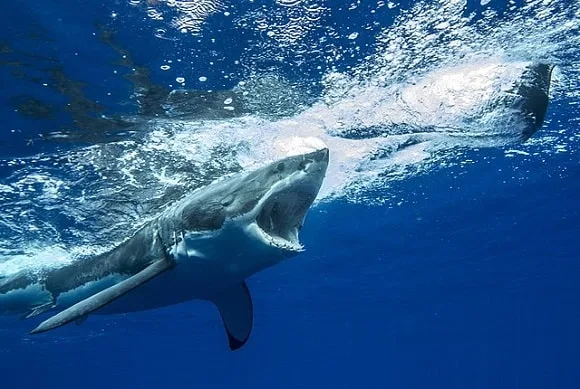
A great white shark’s sense of smell is so acute that it could detect a single drop of blood in an Olympic-sized swimming pool, aiding them in locating prey from great distances.
More research will be necessary, but there is good evidence that the Great White has an impeccable and very well-developed scent-tracking ability.
Millions of years of evolution have produced the perfect ocean predator!
Eye Roll
To protect their eyes while attacking prey, great white sharks are able to roll their eyes back into their heads, leaving only the tough sclerotic coat exposed.
Vocalization Study
This is a really interesting one!
Scientists have discovered that Great Whites are capable of producing low-frequency vocalizations, potentially used for communication or navigation, a phenomenon still under study.
Culinary Preference
Great Whites are known to have a preference for the blubber of marine mammals, which is high in energy, over other body parts, often taking a ‘test bite’ before committing to the hunt.
This could explain their love for seals!
Nautical Navigation
These sharks possess a keen sense of geomagnetic field detection, which they use for navigating across vast oceanic distances, a feature that aids their long migratory journeys.
Cultural Reverence
In some indigenous cultures, the great white shark is revered as a totemic deity, symbolizing strength and guardianship, and features prominently in traditional folklore and rituals.
Now that we have gone through both the basic and amazing facts, let’s take a look at some historic encounters and attacks of Great Whites!
Keep in mind, though, that such incidents are extremely rare and that these sharks are incredible creatures that deserve protection and respect.
5 Historic Great White Shark Encounters
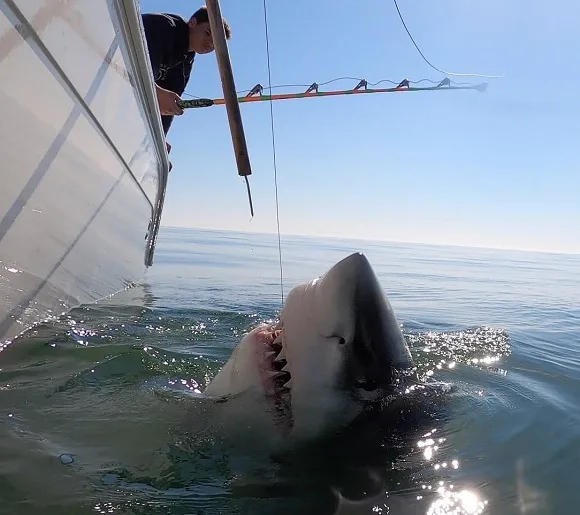
Jersey Shore, 1916
One of the most infamous series of shark attacks occurred along the Jersey Shore in 1916, where four people were killed and one injured over 12 days.
The attacks are said to have inspired Peter Benchley’s novel “Jaws,” which later became a blockbuster film directed by Steven Spielberg.
Despite the fear generated by these events and the resulting popular culture, it’s essential to remember that the Jersey Shore incident was an exceptionally rare one!
DID YOU KNOW: Scientists are actually not completely sure if it really was a great white shark that attacked and killed these five people in 1916. Some believe it might have been the work of a bull shark instead.
USS Indianapolis, 1945
After the sinking of the USS Indianapolis during World War II, the survivors faced numerous shark attacks, among other perils, while awaiting rescue in the Pacific Ocean.
While it is unclear how many of the 900 men in the water were attacked by sharks, this incident remains one of the most well-known in history.
There is also a reference to the incident in the “Jaws” movie, and shark lover or not, it sure is a scary story!
Rodney Fox, 1963
Rodney Fox (aka Sharkman) survived a great white shark attack in 1963 while spearfishing off the coast of South Australia.
Despite severe injuries, Fox became a prominent advocate for shark conservation and played a crucial role in researching and understanding Great Whites.
His story is a testament to the coexistence and mutual respect between humans and sharks.
Deep Blue, 2013
Thomas Butterfield, 2021
To the best of my knowledge, this is the latest reported attack by a great white shark.
Butterfield was bodyboarding in Morro Bay (California) on Christmas Eve 2021 and was attacked by what appeared to be a very large great white shark.
Unfortunately, the attack was so powerful that Butterfield died from the blunt force trauma only minutes later.
A rare but nonetheless very unfortunate and tragic shark encounter!
REMINDER: It is crucial to emphasize that Great White Shark attacks are rare and often result from mistaken identity or curiosity. These majestic creatures play a vital role in marine ecosystems and deserve our protection and respect for the balance they bring to the oceanic environment. Please support great white shark conservation efforts!

